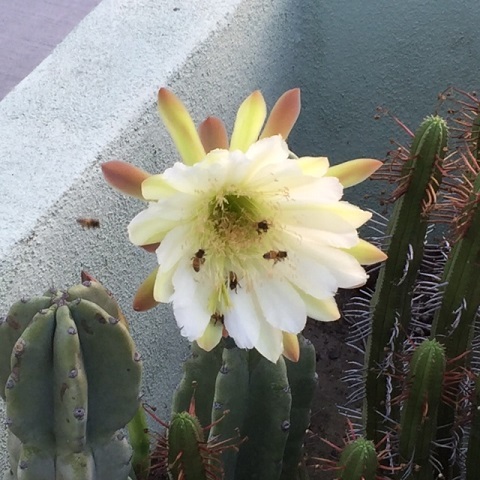- January 16, 2016
- in Green Tips
- by marcos
- 621
- 0

Introducing The Heroes. Honey bees have been working their alchemical magic for over 8,000 years, transforming flower nectar into the sweetness that is honey. Since ancient times, that syrupy goodness has been used for culinary, medicinal, and spiritual purposes across a broad swath of cultures worldwide.
But there is another aspect to their industrious existence that is less well-known to most of us and far more important – the pollination of fruits and vegetables that occurs as they wend their way from blossom to bloom across the landscape. The USDA estimates that “about one mouthful in three in our diet directly or indirectly benefits from honey bee pollination”; that’s a staggering figure. It is also noted that “higher fruit set, larger fruit, uniformly-shaped fruit, and better taste are all indications of successful pollination.”
Some crops, like almonds, are wholly dependent upon honey bees; and there is a long list of everyday produce that is reliant upon the honey bee hives which are trucked from orchard to field in every corner of the land to provide pollination services worth many millions of dollars.
Enter the villain: CCD, or Colony Collapse Disorder. As delineated by the EPA, this is “the phenomenon that occurs when the majority of worker bees in a colony disappear and leave behind a queen, plenty of food and a few nurse bees to care for the remaining immature bees and the queen,” resulting in the death of the colony. Since first described in 2006, beekeepers have reported an alarming rate of attrition throughout North America, and globally as well. In some seasons and in certain areas, losses have reached up to 90 percent within a matter of weeks.
Research is intense and ongoing, and at this point seems to indicate that there is no one cause, but rather an accumulation of factors that interact. Currently, principal culprits are thought to be four: pathogens such as viruses and bacteria; parasites, particularly Varroa mites; management stressors, including overcrowding and migratory stress; and environmental stressors, especially exposure to neonicotinoid pesticides. And some indicators point to GMO plants as possible contributors to CCD, as many of these seeds are dipped in systemic insecticides which may later appear in nectar and pollen.
The Result: It’s hard to predict long-term consequences, but certainly higher food costs resulting from reduced harvests is a strong possibility, not to mention vast harm to the economy on several fronts. But beyond that, there is a larger environmental concern: honey bees are “biological indicators”, one of many barometers of a healthy environment, and disturbances in their life cycle may be the beginning of larger issues. As with all such indicators, vigilance is crucial.
But What Can I Do: Be aware, be concerned, educate yourself, and make your voice heard. Buy organic, to help reduce pesticide use. If you have a yard, eschew pesticides and plant pollinator-friendly plants such as red clover and bee-balm. Buy local and single-producer honey, to support small-scale beekeepers in your own community and elsewhere.
And don’t forget to enjoy the golden sweetness that all those millions of worker bees toiled so mightily to create from their travels.
Spicy Lemon-Honey Chicken
4 6-oz. boneless skinless organic chicken breasts, pounded to 1/4″ thickness
1 tablespoon olive oil
1 teaspoon ground cumin
1 teaspoon smoky paprika
1/2 teaspoon ground coriander
2 tablespoons grapeseed oil
2 tablespoons hot honey (I use Bare Hot & Spicy Honey from Minnesota)
1 tablespoon fresh lemon juice
Pinch cayenne pepper
Moisten chicken cutlets with olive oil and sprinkle with a mixture of the cumin, paprika, and coriander.
Heat grapeseed oil in a large skillet over medium-high heat; add chicken cutlets and cook for about 2 minutes per side, until just cooked through. Remove to a warm platter.
Warm honey, lemon, and cayenne slightly, stir to combine. Drizzle over chicken and serve immediately.
Serves four.
Honey & Grilled Corn Cornbread
1 cup stone-ground yellow cornmeal
1 cup all-purpose flour
1 1/2 tablespoons baking powder
1 tsp. salt
1 egg, lightly beaten
1 cup buttermilk
6 tablespoons organic unsalted butter,
melted & slightly cooled
1/4 cup honey (for this I use Savannah Bee Company Grill Honey – very robust!)
1 cup grilled white corn kernels, cut from the cob (about 2 ears)
glaze:
2 tablespoons unsalted butter
2 tablespoon honey
Pre-heat oven to 375 degrees. Spray an 8×8 glass pan with cooking spray.
In large bowl, combine cornmeal, flour, baking powder & salt; whisk to combine.
In medium bowl, whisk together egg, buttermilk, melted butter & honey to combine. Pour over dry ingredients and stir until just moistened. Fold in corn kernels.
[A version of this post appears in my “Kitchen Matters” column in Better Nutrition Magazine.]
— This feed and its contents are the property of The Huffington Post, and use is subject to our terms. It may be used for personal consumption, but may not be distributed on a website.


